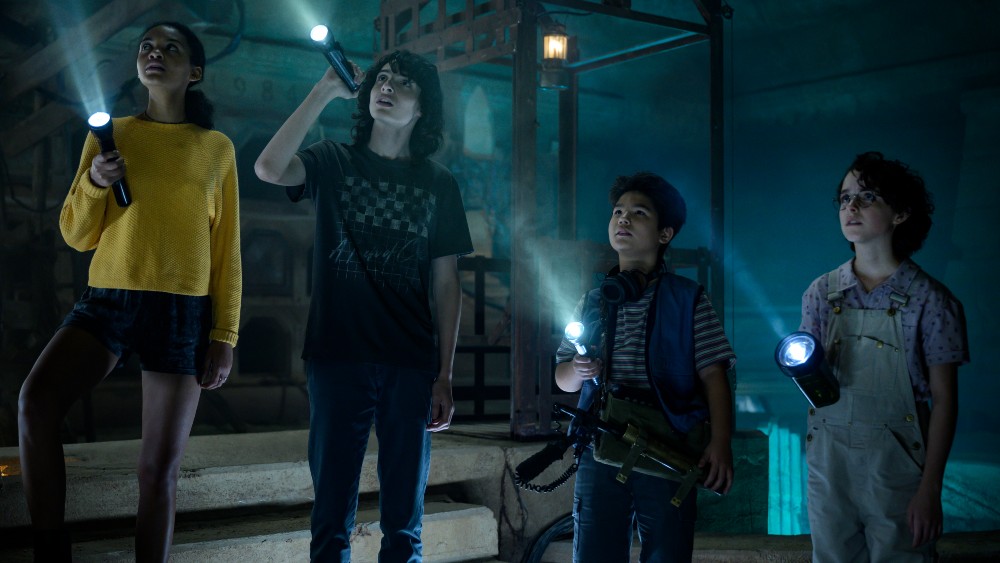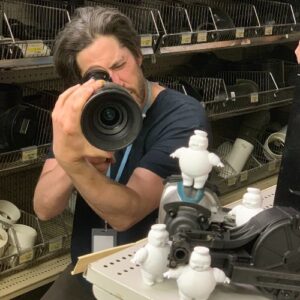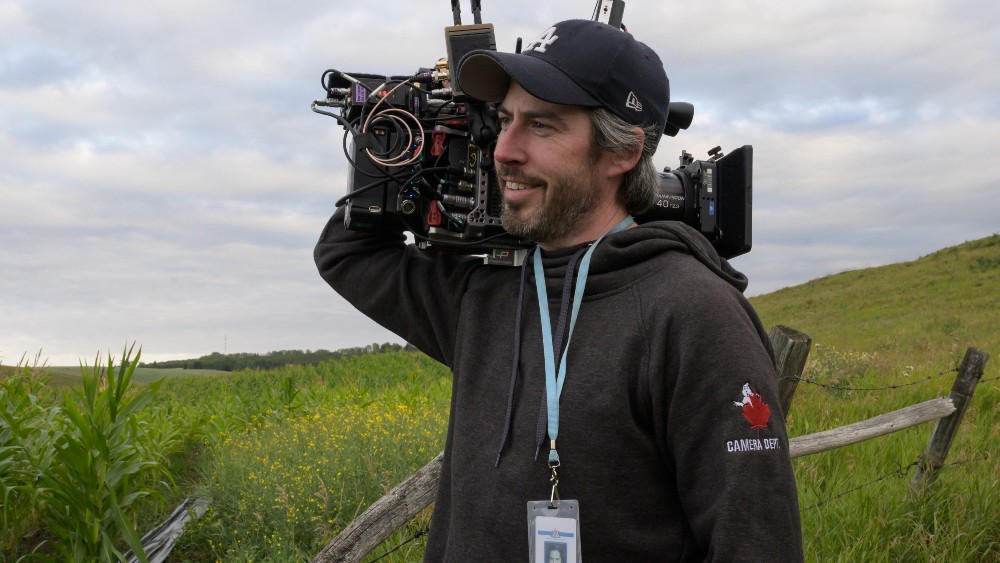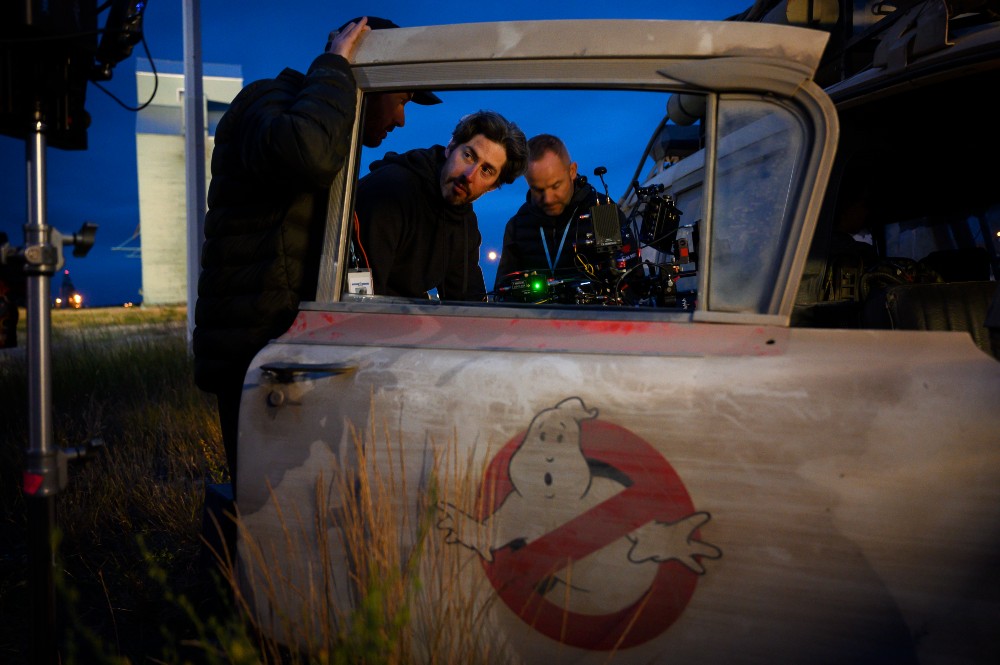
Filmmaker Jason Reitman (Juno, Up in the Air) has been on quite a long journey before arriving at Ghostbusters: Afterlife. Going back 16 years to his feature debut, Thank You For Smoking, the second-gen director has done just about every kind of movie other than the big-budget comedies his father, Ivan Reitman, made famous with his 1984 movie, Ghostbusters. It may not have been deliberate for Jason to try to avoid comparisons with his father, but eventually, he found a way to justify tackling a new version of the comedy classic after delving into just about every other genre over his previous eight features.
Ghostbusters: Afterlife stars Carrie Coon as Callie, the daughter of Harold Ramis’ Spengler, who has to move her kids out to her father’s farm in Summerville, where he spent his last days inventing and becoming known as a bit of a recluse. Callie has also brought her kids, Phoebe (McKenna Grace) and Trevor (Finn Wolfhard), who begin to find and experience strange occurrences. With the help of Phoebe’s science teacher (Paul Rudd) and a few other kids, they start to uncover more of the secrets of Summerville.
Below the Line got on Zoom with Reitman for the following interview about his decision to continue the story begun by his father 37 years earlier. A few days earlier, Reitman premiered Ghostbusters: Afterlife to its first audience at New York Comic-Con where the film was passionately received by the fans.

Below the Line: I quickly want to ask when this movie was supposed to come out, because I remember it was delayed by COVID but can’t remember when it was originally planned for release.
Jason Reitman: We originally were supposed to come out last spring, if you can imagine, and then we push to last summer, and then we pushed to this summer, and then we pushed to Thanksgiving.
BTL: Were you working on it the whole time, or were you close to finishing it already?
Reitman: I mean, we were close to finishing it., but we used that time. It became an opportunity to continue working on visual effects. What made it hard is that we couldn’t screen it for anybody, so we were working in a vacuum.
BTL: I’m glad Sony waited, because I think this movie is the definition of a movie you’d want to see in a theatrical setting. This seems like a very different movie for you, because it’s so VFX-driven but I was also surprised to see that you still worked with a lot of the same people, including some that go back to Thank You For Smoking. It’s amazing to keep the same team when you make such different movies, so is it hard to keep everyone on board?
Reitman: That’s one of my favorite parts of filmmaking. As I’ve been working with my DP Eric Steelberg, since we met when we were teenagers. My First AD/ Producer Jason Blumenfeld since my early 20s. Steve Morrow, my production sound mixer, since Thank You for Smoking. Yeah, Perry Robertson since Thank You for Smoking. I love the people that I get to make movies with. I have the great privilege of getting to go to set and be part of a family that has been growing for two decades now. And while I got to work with all kinds of new people on Ghostbusters, that I’ve never worked with before, guys like Aryan who, you know, created the animatronic terror dog and Visual Effects Supervisor Alessandro [Ongaro], and our Visual Effects Producer Kerry [Joseph]. Will Files, who was our sound effects designer and mixer, who had worked on The Force Awakens. There were all kinds of people like that, that I had never worked with before that were new to me. Or even just a storyboard artist. I’d never worked with a storyboard artist before! In many ways, I was learning how to make this movie as I went, and then in other ways, it was a whole group of us that had grown up together, and we’re now making the kind of movie that we grew up on.
BTL: Rian Johnson does that too. He’s been using the same people going back to Brick, and when you realize that a lot of people who worked on Brick also worked on his Star Wars movie, it’s kind of amazing. Even filmmakers like Steven Spielberg don’t work with the same people he did back in the 80s or 90s. Maybe some of them, but not all of them, you know. Bringing up Spielberg, one of the most striking things about this movie is that it reminded me of some of those great Spielberg movies from the ’80s and ’90s, because it has a sense of awe and wonder that we just don’t get from movies anymore, since they’re far more cynical.
Reitman: That’s the kindest thing you could have said, and this is a film about what it’s like to be young and trying to understand your past, which is something that obviously has consumed Spielberg since he was a young filmmaker. Spielberg’s film had this deep affection for the movies he grew up on, and clearly, Ghostbusters: Afterlife has a deep affection for the films that [Co-screenwriter] Gil Kenan and I grew up on. We grew up in that era. watching his films, and Zemeckis films and my dad’s films, Joe Dante‘s films, filmmakers who were defining what it meant to be young. Young people who were fortunate enough to be set on an adventure, and it’s funny, I mean, I’m the son of a Ghostbuster, I’m making a movie about the grandchildren of Ghostbusters. There’s all this self-reflexive stuff going on as far as the understanding of our pasts.

BTL: Do you have any kids who might one day be the future of the franchise?
Reitman: I have a daughter who’s the same age as Phoebe. I made this movie for my dad, and I made it for my daughter.
BTL: One of the aspects of the movie that reminded me of Spielberg was the music, written by Rob Simonsen, who you had also worked with before, so did a lot of the John Williams aspect of the score come from him?
Reitman: The original score for the original Ghostbusters was written by Elmer Bernstein, who was just one of the great composers of all time. He did many films with my father before that, but he’s probably best known for doing westerns and really being one of the definers of Hollywood original score. Rob Simonsen had never done a score like this. We had worked with each other before on Tully and The Front Runner and is probably more known for his piano work and electronic work. He wanted to show me that he knew exactly how to do this score, so he rented a room at Warner Brothers and created a six-minute piece on his own of what a modern score would look like, while interpreting the Elmer Bernstein score. It was so extraordinary that we actually used it in the movie. He studied everything from Elmer’s original sheet music to the mic plot in the room where they recorded the original score. We actually recorded the same woman who played the Ondes Martenot*. That’s the instrument that you associate with Ghostbusters. It sounds like a theremin, that “ooooooo.” That’s an Ondes Martenot, and the original player from ’84, who lives in London now, we recorded her over Zoom during COVID from Abbey Road.
BTL: I can probably get talking about music all day, but I want to talk about other aspects. I really liked the creation of Summerville, which I read you created in a lot of different places to create an illusion of it being one place. I was curious how you found all those places to put together into the farm and house, which is just an amazing location and set.
Reitman: We shot in Alberta, Canada, which is just one of those beautiful places on earth and is home to more cinematography Oscars than any other geographical location. We shot the same place they shot Days of Heaven and Brokeback Mountain and the original Superman. Actually, we scouted Superman’s farmhouse from 1980, and these towns are disappearing, though. So, to create the town of Somerville, we went from Fort Macleod in the South to Drumheller in the North, a whole bunch of places, and [we] tried to create the small town that we see in our heads.
BTL: Was visual effects involved with things like creating the house we see in the distance while they’re driving through the cornfields?
Reitman: We really built that house, and we built an indoor-outdoor set like they would in the old days. That was one thing that was very important to us, to make this movie the way they would have done it in the 1980s, and that meant everything from practical effects to building set. The temple set is a real set from top to bottom with no green screen, and the house stood in a giant field of snow and had to actually place where the house would be point, the point where the barley would grow and the corn would grow. I felt like a farmer, because I was like watching rain reports to see if the barley would grow so the Ecto-1 could drift through it. But we built that house twice, once out on that hill, and then once on a soundstage, and both were used as interior-slash-exterior sets.

BTL: Is the house still there, or did you have to tear it down?
Reitman: No, I couldn’t believe it. By the time we wrapped, they had already torn it down. It broke my heart. I thought that surely that could at least be a Halloween stop.
BTL: Or it could be like Hobbiton in New Zealand where parts of it are still there and people visit it as a tourist destination.
Reitman: Sadly, it’s gone.
BTL: That’s too bad. You did mention the special effects, but how did you approach the CG and VFX on this, since your father probably didn’t have technology even close to what we have now. How much did you want to use that new technology, and how much did you want to keep what was used for such iconic things like the proton beam?
Reitman: Totally. Something we talked about all the time on set was how do we capture the original recipe of the ’84 film, and the trick was a combination of leading-edge visual effects with classic old-school Hollywood technique. So, we were using wires, we were using dry ice, we were using magnets to move chess pieces, and we were using animatronic puppets like the Terror Dog. And then, at the same time, we were creating proton beams using the latest technology, so that they would simulate what would actually happen to a proton beam when driving 80 miles an hour. We were creating all kinds of effects that are used in the final set piece, which I can’t describe in detail, but there were visual effects so complex in the last act that we had to create technology to do them and took the duration of the entire prep, shoot and post to complete.
BTL: I’m sure a lot of the VFX team and a lot of the crew were huge fans of the original Ghostbusters, too, and were excited to tackle that challenge. A lot of people are waiting for COVID to be done with and for it to be safer to shoot, so are you developing anything to do next once that’s possible?
Reitman: Being at Comic-Con the other night was a fascinating experience for me. It was my first time at a Comic-Con as a director, and what I found it similar to was being at Sundance, being at Toronto, being in a room with 1,000 people who love movies. It was this real eyeopener as far as my ability to make Sundance films or Comic-Con films, and I’d like to continue doing both.
Ghostbusters: Afterlife hits theaters nationwide, beginning November 19. All photos courtesy and copyright Sony Pictures. Photographer: Kimberley French.
You can also read our review of Ghostbusters: Afterlife.
* If you’re interested in learning more about the Ondes Martenot as an instrument, you can check out this great video, which talks about how Radiohead’s Jonny Greenwood, who also has provided the soundtrack for three potential Oscar movies this year, helped revive the instrument with his music.





